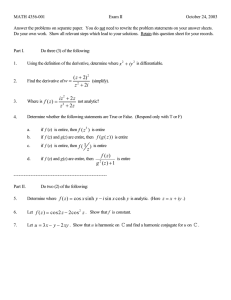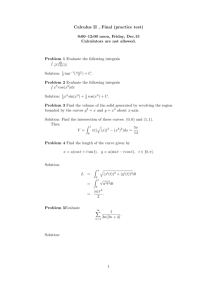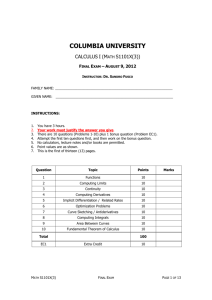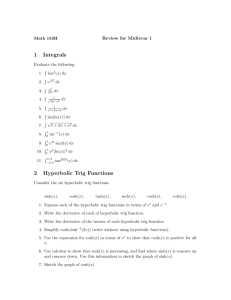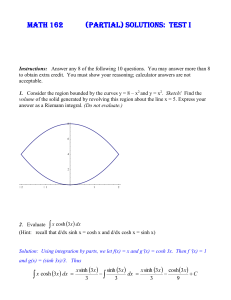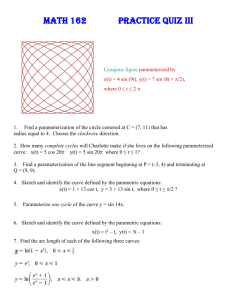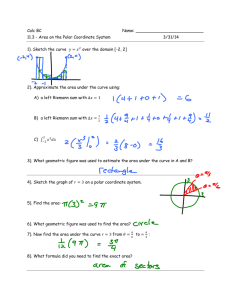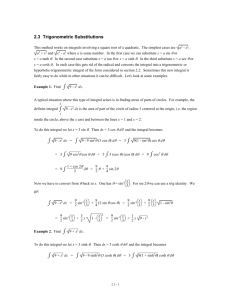Math 101 Final Exam Review Questions ∫
advertisement
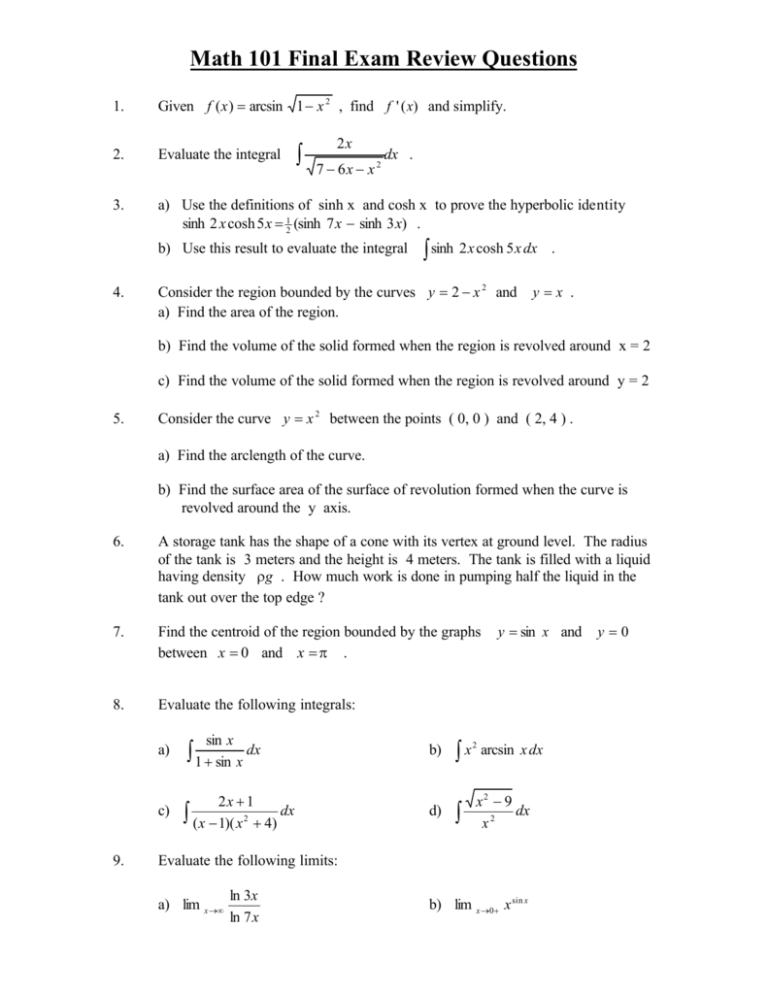
Math 101 Final Exam Review Questions 1. Given f ( x ) = arcsin 1 − x 2 , find f ' ( x) and simplify. 2. Evaluate the integral 3. a) Use the definitions of sinh x and cosh x to prove the hyperbolic identity sinh 2 x cosh 5 x = 12 (sinh 7 x − sinh 3 x) . ∫ 2x 7 − 6x − x 2 dx . b) Use this result to evaluate the integral 4. ∫ sinh 2 x cosh 5 x dx Consider the region bounded by the curves y = 2 − x 2 and a) Find the area of the region. . y=x . b) Find the volume of the solid formed when the region is revolved around x = 2 c) Find the volume of the solid formed when the region is revolved around y = 2 5. Consider the curve y = x 2 between the points ( 0, 0 ) and ( 2, 4 ) . a) Find the arclength of the curve. b) Find the surface area of the surface of revolution formed when the curve is revolved around the y axis. 6. A storage tank has the shape of a cone with its vertex at ground level. The radius of the tank is 3 meters and the height is 4 meters. The tank is filled with a liquid having density ρg . How much work is done in pumping half the liquid in the tank out over the top edge ? 7. Find the centroid of the region bounded by the graphs between x = 0 and x = π . 8. Evaluate the following integrals: 9. sin x a) ∫ 1 + sin x dx b) c) 2x + 1 ∫ (x − 1)( x 2 + 4) dx d) ∫x ∫ 2 y = sin x and arcsin x dx x2 − 9 dx x2 Evaluate the following limits: a) lim x →∞ ln 3x ln 7 x b) lim x →0+ x sin x y=0 ∞ 10. Sketch the area represented by the integral 1 ∫ (x − 1) dx then use limits to write 3 0 the expression you would need to evaluate in order to calculate the integral. Make sure the expression is correct in every detail and then evaluate it if possible. 11. Use any appropriate test to determine if the following series converge or diverge. For alternating series distinguish between conditional and absolute convergence. ∞ ∞ 1 ∑ n + ln n n= 2 a) ∞ n ∞ 12. ∞ n ∑ (−1) 5n + 1 n =1 c) The series nn ∑ n =1 n! b) ∑ (−1) d) n n= 2 n! ∑ (n + 2)! 1 n (ln n) is actually a telescoping series in disguise. Find the exact n= 4 sum. ∞ 13. Find the interval of convergence for the power series ∑ ( x − 1) n n 5n n =1 . Be sure to check the endpoints. f ( x ) = tan x centered at 14. Find the fourth degree Taylor polynomial for 15. It is possible (at least in theory!) to evaluate the integral π 4 . 1 dx for all +1 natural numbers k ≥ 3 using partial fractions however this gets ugly as k gets 1 big. Find a power series expansion for 5 centered at zero and then x +1 1 integrate it to get a power series expansion for ∫ 5 dx centered at zero. x +1 1 16. x= ∫x k x2 − 1 a) The integral e ∫ 2 dx represents the probability that a standard normal 2π 0 random variable takes on a value between 0 and 1. Create a power series for e − x2 2 and then integrate it to find a power series for 1 ∫e x2 − x2 2 dx . Use the first 4 − 1 terms of this power series to approximate e ∫ 2 dx . 2π 0 b) Estimate the size of the error in your approximation in part a) using the fact that the series is an alternating series. x = cosh t + 2 17. Consider the parametric equations : . Use a hyperbolic y = sinh t + 3 identity to write the corresponding rectangular equation. Sketch the parametric curve and indicate the orientation. 18. Consider the parametric curve defined by : Find 19. dy dx x = 1 + sin t y = t − 2 cos t 0 ≤ t ≤ 2π . and also all points of vertical and horizontal tangency. Find the arc length of the parametric curve defined by : x = 2t 3 y = 3t 2 + 1 0≤t≤2 . r = 1 + 3 sin θ , 0 ≤ θ ≤ 2π 20. Sketch the polar graph defined b: 21. a) The equation r = cos 2θ is a rose curve with four petals ( see P. 674, 677 ). Convert this equation to rectangular coordinates. b) Convert the equation . y = mx + b to polar coordinates and solve for r . 22. Find the area trapped between the polar graphs : A sketch of the area will be helpful. 23. Consider the cardioid defined by : r = 1 + cosθ . r = 3 sin θ and r = cos θ . a) Find its perimeter, a sketch might be helpful. b) Find the surface area of the surface formed when the upper half of the cardioid defined for 0 ≤ θ ≤ π is revolved around the polar axis.
